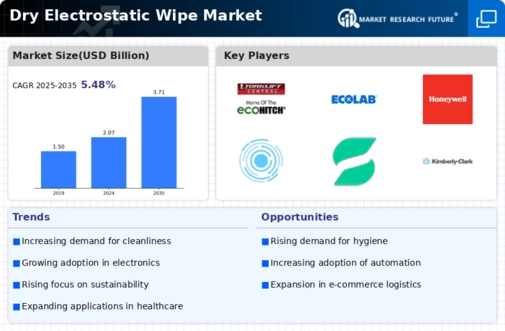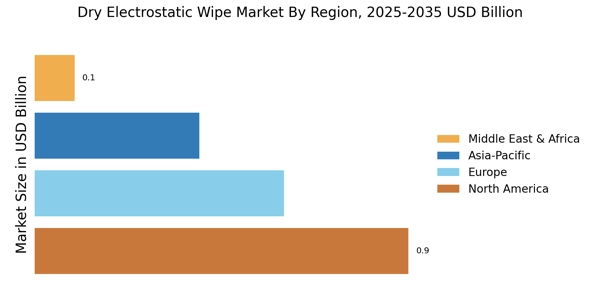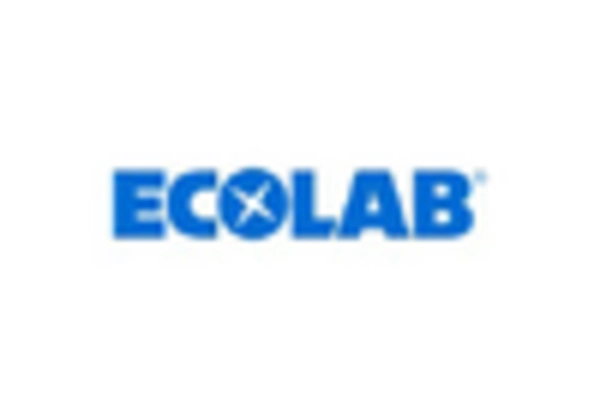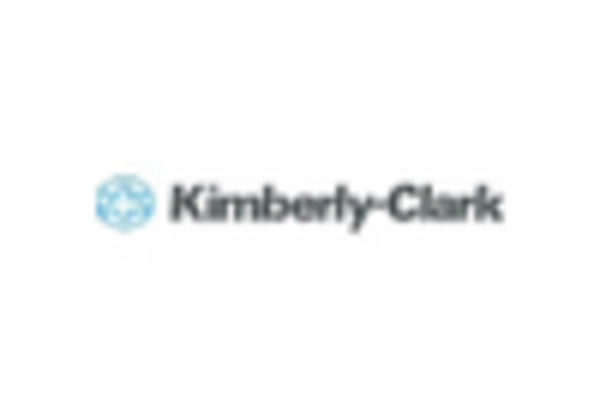Expansion in Automotive Sector
The automotive industry is increasingly recognizing the importance of cleanliness in manufacturing processes, which is positively impacting the Dry Electrostatic Wipe Market. As vehicles become more technologically advanced, the need for specialized cleaning solutions has grown. Dry electrostatic wipes are particularly effective in removing dust and particles from sensitive components without causing damage. The automotive sector is projected to witness a growth rate of around 4% annually, which could lead to a corresponding increase in the demand for dry electrostatic wipes. This trend suggests that as automotive manufacturers continue to innovate, the need for effective cleaning solutions will likely remain a priority, thereby benefiting the industry.
Regulatory Compliance and Standards
The Dry Electrostatic Wipe Market is significantly influenced by stringent regulatory compliance and standards across various sectors. Industries such as pharmaceuticals and food processing are subject to rigorous cleanliness regulations, necessitating the use of effective cleaning products. Dry electrostatic wipes are increasingly recognized for their ability to meet these standards, as they effectively eliminate contaminants without the use of chemicals. As regulatory bodies continue to enforce higher cleanliness standards, the demand for dry electrostatic wipes is expected to rise. This trend indicates that compliance with health and safety regulations will play a crucial role in shaping the market landscape, potentially leading to increased adoption of these wipes.
Increased Focus on Workplace Hygiene
In the context of heightened awareness regarding workplace hygiene, the Dry Electrostatic Wipe Market is poised for growth. Organizations across various sectors are prioritizing cleanliness to ensure employee safety and productivity. Dry electrostatic wipes offer a convenient solution for maintaining clean surfaces, particularly in high-touch areas. The market for cleaning products is expected to reach a valuation of several billion dollars, with dry electrostatic wipes capturing a significant share due to their effectiveness. This emphasis on hygiene not only reflects changing consumer preferences but also indicates a broader trend towards maintaining health standards in workplaces, thereby enhancing the market's potential.
Growth in E-commerce and Retail Sectors
The rise of e-commerce and retail sectors is contributing to the expansion of the Dry Electrostatic Wipe Market. As online shopping continues to gain traction, the need for maintaining cleanliness in warehouses and distribution centers has become paramount. Dry electrostatic wipes are favored for their efficiency in cleaning surfaces quickly and effectively, which is essential in fast-paced environments. The retail cleaning products market is anticipated to grow significantly, with dry electrostatic wipes likely capturing a notable share due to their convenience and effectiveness. This trend suggests that as e-commerce continues to evolve, the demand for specialized cleaning solutions will likely increase, further propelling the industry forward.
Rising Demand in Electronics Manufacturing
The Dry Electrostatic Wipe Market is experiencing a notable surge in demand, particularly within the electronics manufacturing sector. As manufacturers strive for higher cleanliness standards to ensure product quality, the need for effective cleaning solutions has intensified. Dry electrostatic wipes, known for their ability to remove dust and contaminants without leaving residues, are increasingly favored. Reports indicate that the electronics sector is projected to grow at a compound annual growth rate of approximately 5% over the next few years, further driving the demand for these wipes. This trend suggests that as electronic devices become more intricate, the necessity for specialized cleaning products like dry electrostatic wipes will likely expand, positioning the industry for sustained growth.


















Leave a Comment